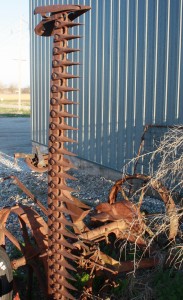 Careful where you go burning grass or haphazardly cutting weeds because you never know what might be hiding amongst the rubbish. Along with the spike tooth disk, I found this sickle mower for mowing hay, grass or weeds. (Looks like it needed to be used right where it was sitting!) The operator sat on the seat to drive the horses that pulled the mower.
Careful where you go burning grass or haphazardly cutting weeds because you never know what might be hiding amongst the rubbish. Along with the spike tooth disk, I found this sickle mower for mowing hay, grass or weeds. (Looks like it needed to be used right where it was sitting!) The operator sat on the seat to drive the horses that pulled the mower.
A short history on this mower:
Sickle mowers have a long bar on which is mounted fingers with stationary guardplates. In a channel on the bar there is a reciprocating sickle with very sharp sickle sections (triangular blades). The sickle bar is driven back and forth along the channel. The grass is cut between the sharp edges of the sickle sections and the finger-plates (this action can be likened to an electric hair clipper).
The bar rides on the ground, supported on a skid at the inner end, and it can be tilted to adjust the height of the cut. A spring-loaded board at the outer end of the bar guides the cut hay away from the uncut hay. The so-formed channel, between cut and uncut material, allows the mower skid to ride in the channel and cut only uncut grass cleanly on the next swath. These were the first successful horse-drawn mowers on farms and the general principles still guide the design of modern mowers.
Source: Wikipedia. (Where else?)
Today, we use large hay and forage disc mowers, built for compact tractors or full-size operations. If you want big, they got big. This modest sickle mower got its start around 1914 and is anything but big, but it got the job done.
Until our next history lesson …
